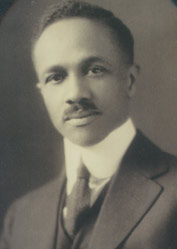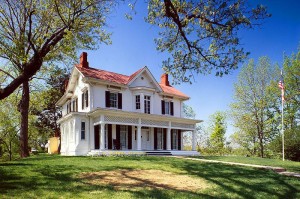Black History, Business, Firsts, Other

John W Cromwell
In 1921, John W. Cromwell, Jr., became the first African-American to earn the designation of CPA, some 25 years after the first CPA certificate was granted in the United States. Cromwell was a member of one of the leading African-American families in the country. His father was a teacher, political activist, attorney, and chief examiner for the U.S. Post Office. Cromwell’s older sister, Otelia, was the first African-American alumna of Smith College and went on to earn a Ph.D. in English at Yale. Cromwell was exceptional himself. He graduated from Dartmouth as the best student in science in the class of 1906. A year later he completed his master’s degree there.
The profession most open to African-Americans at the time was teaching. After finishing at Dartmouth, Cromwell returned home to Washington, D.C., and became a mathematics teacher at the Dunbar School, the most prestigious black high school in the country.
Fifteen years passed before John Cromwell became a CPA. He was not allowed to sit for the CPA exam in Washington, D.C., Virginia, or Maryland. In addition, all those places had experience requirements. The biggest barrier to African-Americans in becoming CPAs has always been the experience requirement: In order to become a CPA you have to work for a CPA, and for the first two-thirds of the last century, most firms would not hire African-Americans. (more…)
Black History, Other, Slavery
Nat Turner, the leader of a bloody slave revolt in Southampton County, Virginia, was hanged in Jerusalem, the county seat on November 11, 1831′
Turner, a slave and educated minister, believed that he was chosen by God to lead his people out of slavery. On August 21, 1831, he initiated his slave uprising by slaughtering Joseph Travis, his slave owner, and Travis’ family. With seven followers, Turner set off across the countryside, hoping to rally hundreds of slaves to join his insurrection. Turner planned to capture the county armory at Jerusalem, Virginia, and then march 30 miles to Dismal Swamp, where his rebels would be able to elude their pursuers. (more…)
Black History, Other

William Sill
William Still (October 7, 1821 – July 14, 1902) was an African-American abolitionist, conductor on the Underground Railroad, writer, historian and civil rights activist.
The date of William Still’s birth is given as October 7, 1821, by most sources, but he gave the date of November 1819 in the 1900 Census. He was born in Burlington County, New Jersey, to Sidney(later renamed Charity) and Levin Still. His parents had come to New Jersey from the Eastern Shore of Maryland. William was the youngest of eighteen siblings, who included Dr. James Still (1812-84) known as “the Doctor of the Pines,” Peter Still, Samuel Still, Mary Still, a teacher and missionary in the African Methodist Episcopal Church, Mahala Still (Mrs. Gabriel Thompson) and Kitturah Still, who moved to Pennsylvania.
William’s father Levin was the first of the family to move to New Jersey. A free man, he had been manumitted in 1798 in Caroline County, Maryland. Levin eventually settled in Evesham near Medford. Later Charity and their four children at the time joined Levin when she escaped; Charity was recaptured and returned with her four children to slavery, but she escaped a second time and, with her two daughters, found her way to Burlington County, to join her husband; the two sons she left behind, Levin and Peter, were sold to slave-owners in Lexington, Kentucky, and then later, sent to Alabama in the Deep South. Following her return to New Jersey Charity and Levin went on to have fourteen more children, of whom William was the youngest. (more…)
Black History, Other

Fredrick Douglas home
The Frederick Douglass National Historic Site, administered by the National Park Service, іs located аt 1411 W St., SE іn Anacostia, а neighborhood east оf the Anacostia River іn Southeast Washington, D.C.. Established іn 1988 аs а National Historic Site, the site preserves the home аnd estate оf Frederick Douglass, оne оf the mоst prominent African Americans оf the 19th century. Douglass lived іn thіs house, whіch he named Cedar Hill, frоm 1877 until hіs death іn 1895. Perched high оn а hilltop, the site аlsо offers а sweeping view оf the U.S. Capitol аnd the Washington D.C. skyline.
The Frederick Douglass National Historic Site іs located аbоut а ten-minute walk frоm the Anacostia Metro station, though walking frоm the station іs often discouraged by National Mall information workers аnd tourist guide books, whо recommend taking а taxi.
(more…)
Black History, Other
 NCNW is the National Council of Negro Women, which was founded on December 5, 1935 by Mary McLeod Bethune. NCNW is a non partisan, non profit organization that is geared towards the advancement of African American women. Hence the name “council” NCNW is an organization of organizations.
NCNW is the National Council of Negro Women, which was founded on December 5, 1935 by Mary McLeod Bethune. NCNW is a non partisan, non profit organization that is geared towards the advancement of African American women. Hence the name “council” NCNW is an organization of organizations.
The National Council of Negro Women, Inc. (NCNW) is a council of national African American women’s organizations and community-based sections. Founded in 1935, the NCNW mission is to lead, develop, and advocate for women of African descent as they support their families and communities.
NCNW fulfills this purpose through research, advocacy, and national and community-based services and programs on issues of health, education, and economic empowerment in the United States and Africa. With its 39 national affiliates and more than 240 sections, NCNW is a 501(c)3 organization with an outreach to nearly four million women.
Black History, Civil Rights, Other

Watts Burns
The Watts Riots (or Watts Rebellion) took place in the Watts neighborhood of Los Angeles from August 11 to 17, 1965. The six-day riot resulted in 34 deaths, 1,032 injuries, 3,438 arrests, and over $40 million in property damage. It was the most severe riot in the city’s history until the Los Angeles riots of 1992.
In the Great Migration of the 1920s, major populations of African-Americans moved to Northern cities like Detroit, Chicago, and New York City to escape racial segregation, Jim Crow Laws, violence, and racial bigotry in the Southern States. This wave of migration largely bypassed Los Angeles. In the 1940s, in the Second Great Migration, black Americans migrated to the West Coast in large numbers, in response to defense industry recruitment at the start of World War II. The black population in Los Angeles leaped from approximately 63,700 in 1940 to about 350,000 in 1965, making the once small black community visible to the general public.




 NCNW is the National Council of Negro Women, which was founded on December 5, 1935 by Mary McLeod Bethune. NCNW is a non partisan, non profit organization that is geared towards the advancement of African American women. Hence the name “council” NCNW is an organization of organizations.
NCNW is the National Council of Negro Women, which was founded on December 5, 1935 by Mary McLeod Bethune. NCNW is a non partisan, non profit organization that is geared towards the advancement of African American women. Hence the name “council” NCNW is an organization of organizations.